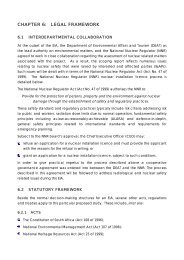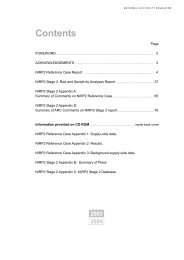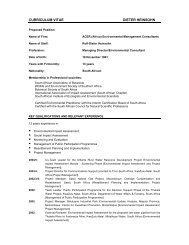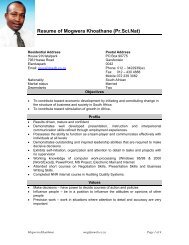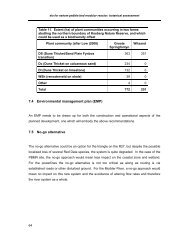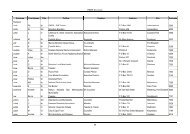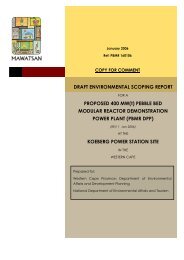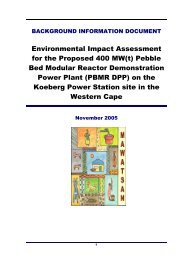Appendix B - Plan of Study Checklist May 08 - PBMR
Appendix B - Plan of Study Checklist May 08 - PBMR
Appendix B - Plan of Study Checklist May 08 - PBMR
You also want an ePaper? Increase the reach of your titles
YUMPU automatically turns print PDFs into web optimized ePapers that Google loves.
APPENDIX B:<br />
CHECKLIST OF COMPLIANCE WITH REQUIREMENTS FOR THE PLAN OF STUDY FOR EIA FOR THE PROPOSED PEBBLE BED MODULAR REACTOR<br />
ENVIRONMENTAL IMPACT ASSESSMENT<br />
This checklist has been compiled to assist in ensuring that all requirements for the <strong>Plan</strong> <strong>of</strong> <strong>Study</strong> for EIA have been addressed. The categorisation and source <strong>of</strong> the requirements is provided in<br />
the table below.<br />
Category No. Category Source <strong>of</strong> Requirement<br />
1 Legal requirements – Environment Conservation Act 1 • Regulation 7 <strong>of</strong> Government Notice R.1183 (as amended), promulgated in terms <strong>of</strong> sections 26 and 28 <strong>of</strong> the<br />
Environment Conservation Act, 1989 (Act 73 <strong>of</strong> 1989)<br />
2 DEAT specific requirements • Department <strong>of</strong> Environmental Affairs and Tourism (DEAT) response (April 2006) to the Final Scoping Report and<br />
<strong>Plan</strong> <strong>of</strong> <strong>Study</strong> for EIA<br />
3 Legal requirements – National Environmental Management Act 2 • Regulation 29 <strong>of</strong> Government Notice R.385, promulgated in terms <strong>of</strong> section 24 <strong>of</strong> the National Environmental<br />
Management Act, 1998 (Act 107 <strong>of</strong> 1998)<br />
4 DEAT specific requirements • Department <strong>of</strong> Environmental Affairs and Tourism (DEAT) response (March 20<strong>08</strong>) to the Draft <strong>Plan</strong> <strong>of</strong> <strong>Study</strong> for EIA<br />
(dated 18 July 2007)<br />
5 Guideline requirements 3 • DEAT ECA guideline<br />
• DEADP Guidelines on Specialist Studies<br />
• NEMA EIA Regulations Guideline Series<br />
1<br />
The EIA regulations promulgated under the Environment Conservation Act are applicable to the application.<br />
2<br />
The EIA regulations promulgated under the National Environmental Management Act are not applicable to this application. Reference to compliance with these regulations is provided in order to demonstrate that<br />
these requirements have been considered in the compilation <strong>of</strong> the <strong>Plan</strong> <strong>of</strong> <strong>Study</strong> for EIA.<br />
3<br />
These requirements are not detailed within the checklist. The <strong>Plan</strong> <strong>of</strong> <strong>Study</strong> for EIA however makes reference to the various guidelines and indicates compliance therewith in the relevant sections <strong>of</strong> the document.
Requirement<br />
Number<br />
Requirement<br />
Section/s <strong>of</strong> this Report Where Requirement has Been<br />
Addressed<br />
1. Legal Requirements – Environment Conservation Act<br />
1.1 A description <strong>of</strong> the environmental issues identified during scoping that may require further investigation and Section 4<br />
assessment<br />
1.2 A description <strong>of</strong> the feasible alternatives identified during scoping that may be further investigated Section 3.5 and Section 5.5.1<br />
1.3 An indication <strong>of</strong> additional information required to determine the potential impacts <strong>of</strong> the proposed activity on the Section 6<br />
environment<br />
1.4 A description <strong>of</strong> the proposed method <strong>of</strong> identifying these impacts Section 5.2<br />
1.5 A description <strong>of</strong> the proposed method <strong>of</strong> assessing the significance <strong>of</strong> these impacts Section 5.2<br />
2. DEAT Specific Requirements – April 2006<br />
2.1 Comments received from IAPs after the submission <strong>of</strong> the FSR to the authorities, as well as the comments from the Section 3.4<br />
various authorities on the FSR, should be included in the revised FSR and carried into the POS for EIA<br />
2.2 The views <strong>of</strong> those national departments with an interest in, affected by, or responsible for, the proposed project should Section 4<br />
be obtained and reflected in the revised FSR and carried into the POS for EIA<br />
2.3 Issues need to be clearly and consistently described to allow tracking through the Scoping report and the plan <strong>of</strong> study Section 4<br />
for EIA to the EIR. The DEAT recommends that the issues are grouped into logical themes with ‘signature words’ (eg<br />
‘health’, ‘economics’) that are used consistently throughout the EIA documentation. The use <strong>of</strong> simple coding could<br />
assist in the tracking <strong>of</strong> issues<br />
2.4 Issues that were raised in the 302MW(t) EIA and are relevant to the current EIA process should be included in the Section 4
evised FSR, noting them as such. Any issues not covered in the Final FSR must be carried through into the POS for<br />
EIA<br />
2.5 Issues raised by IAPs must be used to provide focused questions to which answers are required as the basis for Section 4.2 and Section 6<br />
drawing up sound Terms <strong>of</strong> Reference for specialist studies in the EIA phase, to be included in the POS for EIA.<br />
Issues that are to be addressed in the EIA phase should be clearly assigned to specific specialist studies<br />
2.6 Clear Terms <strong>of</strong> Reference for the various studies needed in the EIA phase should be provided for comment by the Section 5.2 and Section 6<br />
authorities prior to proceeding with this phase, as part <strong>of</strong> the revised POS for EIA. The TOR should set the time and<br />
spatial boundaries for the study, provide a clear protocol and criteria for assessing potential impacts and evaluating<br />
their significance, and should specify the format and timing <strong>of</strong> deliverables. (The Integrated Environmental<br />
Management Information Series and the Western Cape Department <strong>of</strong> Environmental Affairs and Development<br />
<strong>Plan</strong>ning Guidelines for Determining the Scope <strong>of</strong> Specialist Guidelines provide useful references in this respect.) The<br />
TOR for each specialist should capture explicit questions that require focused answers from that specialist, to ensure<br />
that the scope <strong>of</strong> work is clearly defined and that information gathering, assessment and evaluation is <strong>of</strong> direct<br />
relevance<br />
3. Legal requirements – National Environmental Management Act<br />
3.1 A description <strong>of</strong> the tasks that will be undertaken as part <strong>of</strong> the environmental impact assessment process, including Section 5 and Section 6<br />
any specialist reports or specialised processes, and the manner in which such tasks will be undertaken<br />
3.2 An indication <strong>of</strong> the stages at which the competent authority will be consulted Section 5.5<br />
3.3 A description <strong>of</strong> the proposed method <strong>of</strong> assessing the environmental issues and alternatives, including the option <strong>of</strong> Section 5.2 and Section 5.3<br />
not proceeding with the activity<br />
3.4 Particulars <strong>of</strong> the public participation process that will be conducted during the environmental impact assessment<br />
process<br />
Section 5.4
3.5 Any specific information required by the competent authority See sections below in response to requirements 11 to 16<br />
4. DEAT Specific Requirements – March 20<strong>08</strong><br />
1 Provision should be made for both the Department <strong>of</strong> Public Enterprises and the Department <strong>of</strong> Trade and Industry to Section 5.6.6<br />
have input into the POS, to ensure that their issues or concerns are carried through to the EIA.<br />
2 You are requested to carry out a thorough check <strong>of</strong> all potentially significant issues raised during scoping to give Section 4<br />
assurance that they are incorporated in the POS. Where issues are not incorporated, an explanation for their exclusion<br />
should be supplied.<br />
3 The EIA should explain the relationship between the various institutions and shareholders that have a stake in the This will be provided within the EIA Report<br />
<strong>PBMR</strong> company.<br />
4 The EIA should explicitly address the fate <strong>of</strong> financial investment in the PMBR DPP in terms <strong>of</strong> future economic Section 6.4.12<br />
pathways (i.e. potential costs and benefits to the country).<br />
5 The EIR should include a ‘scene-setting’ chapter which describes the strategic context and the opportunities, Section 4.3<br />
constraints and risks that this context might pose to the <strong>PBMR</strong> DPP as a point <strong>of</strong> departure for the EIA. These strategic<br />
issues should both inform, and provide a benchmark against which, project level impacts are evaluated.<br />
6 The EIA should provide a clear and easily understood rationale for increasing the size and changing the configuration Section 2.3<br />
<strong>of</strong> the proposed <strong>PBMR</strong> DPP.<br />
7 The EIA should give an explanation <strong>of</strong> the components <strong>of</strong> the proposed technology that have been tested and those Section 2.3 and Section 2.4<br />
that have not been tested so as to differentiate between untried and new aspects <strong>of</strong> the proposed <strong>PBMR</strong> DPP project.<br />
8 The POS should paint a clear picture <strong>of</strong> how specialist studies are to be integrated by the environmental consultant, Section 6.5<br />
and how an overall assessment <strong>of</strong> the project will be presented.<br />
9 The environmental consultant should appoint specialist peer reviewers to review potentially contentious specialist Section 6.6<br />
studies prior to their inclusion in the EIR.<br />
10 The EIA should include:
• An explicit description <strong>of</strong> ‘the study area’ and its boundaries;<br />
• A description <strong>of</strong> the decision-making framework and different authorisations/permits, and <strong>of</strong> how decisionmaking<br />
will be synchronised to expedite the authorisation process; and<br />
• Consideration <strong>of</strong> recent draft policy and legislation.<br />
11 The proposed impact assessment methodology should be revised to:<br />
• Relate significance ratings to accepted societal norms, standards, legal requirements, plans and other<br />
yardsticks;<br />
• Minimise reducing multiple variables by ending the conflation with ‘consequence’ ratings;<br />
• Address cumulative effects separately;<br />
• Identify permanent impacts; and<br />
• Include assurance <strong>of</strong> mitigation in the evaluation <strong>of</strong> residual significance <strong>of</strong> impacts.<br />
12 Specific provision should be made for focus group meetings with the Legal Resources Centre/Earthlife Africa and<br />
Ministry <strong>of</strong> Health (Western Cape).<br />
13 Should the EIA use potentially controversial specialists, peer reviewers with international creditability should be<br />
appointed to ensure balance in pr<strong>of</strong>essional judgement.<br />
14 Separate studies by recognised and well-respected specialists should be commissioned to address social impacts and<br />
economic impacts.<br />
15 The environmental consultant should re-visit the need for the large number <strong>of</strong> specialist studies in the light <strong>of</strong> the<br />
potentially significant issues raised during scoping.<br />
16 The general TOR should be amended to include:<br />
• Any legal requirements, norms, standards or other limits <strong>of</strong> acceptable change applicable to the particular<br />
field <strong>of</strong> study as a benchmark against which specialists should evaluate significance;<br />
• Background trends and patterns that may be a concern or issue or pose a threat to the proposal and/or<br />
Section 5.2<br />
Section 5.3<br />
Section 2.8<br />
Section 5.4<br />
Section 5.6.6<br />
Section 6.6<br />
Section 6.4.12<br />
Section 6.4<br />
Section 6.3.1 and Section 6.3.2
influence the evaluation <strong>of</strong> impact significance (e.g. plans to expand urban areas, informal settlement<br />
patterns, epidemiological information, pollution);<br />
• Probable/likely factors informing cumulative impacts, including those associated with the background level <strong>of</strong><br />
nuclear activity at the Koeberg site;<br />
• Identification and explicit statement <strong>of</strong> any impacts on irreplaceable resources, areas <strong>of</strong> major uncertainty,<br />
gaps in information, low confidence levels; and<br />
• Evaluation by each specialist <strong>of</strong> potential impacts in terms <strong>of</strong> the NEMA principles, as <strong>of</strong> particular relevance<br />
to the specialist’s field <strong>of</strong> study.<br />
17 The environmental consultant should ensure that the need for all <strong>of</strong> the specialist studies is justified, and that the TOR<br />
for each specialist is tailored to address the key case- and context-specific issues.<br />
18 The specialist study on air quality should consider:<br />
• Possible cumulative impacts associated with emissions; and<br />
• Possible synergistic effects <strong>of</strong> the <strong>PBMR</strong> and KNPS emissions, both radiological and non-radiological, in<br />
normal and upset or emergency conditions.<br />
19 The TOR for the specialist studies on health impact and radiological health and safety (Section 6.3.19) need to be<br />
rationalised in order to avoid duplication in addressing impacts due to radioactive and non-radioactive emissions.<br />
20 The specialist study on visual impact should give a clear visual impression <strong>of</strong> the size and dimensions <strong>of</strong> the <strong>PBMR</strong><br />
DPP plant in scale comparison with the Koeberg nuclear power station.<br />
21 The specialist economic study should address the following:<br />
• Risks to the South African economy, and probable consequences <strong>of</strong>, investing in the <strong>PBMR</strong> DPP;<br />
• The opportunity costs <strong>of</strong> investing in this particular technology in relation to other technologies; and<br />
• The distributional impacts in terms <strong>of</strong> potential costs and benefits, and a clear description <strong>of</strong> parties who<br />
stand to benefit from, or bear the costs <strong>of</strong>, the <strong>PBMR</strong> DPP.<br />
Section 6.4<br />
Section 6.4.1<br />
Section 6.3.19<br />
Section 6.4.3<br />
Section 6.4.12
22 The specialist study on meteorology and oceanography needs to include a risk assessment and implications for design<br />
<strong>of</strong> the <strong>PBMR</strong> DPP.<br />
23 The TOR for the specialist study on epidemiology should be re-worded to reflect DEAT’s requirements to provide an<br />
epidemiological pr<strong>of</strong>ile <strong>of</strong> the population <strong>of</strong> Cape Town in general and <strong>of</strong> the ‘critical group’ within the 16km radius <strong>of</strong><br />
the Koeberg site, including a baseline study on epidemiological issues related to childhood leukaemia in Cape Town.<br />
24 The specialist study on land use should address the opportunity cost to the City <strong>of</strong> siting the <strong>PBMR</strong> at the KNPS site. In<br />
addition, the cumulative impact <strong>of</strong> using the existing infrastructure and services to support the <strong>PBMR</strong> DPP should be<br />
addressed.<br />
25 The specialist study on radiological waste management should address:<br />
• The nature <strong>of</strong> the waste in terms <strong>of</strong> both its quantity and type;<br />
• Whether or not the waste from the <strong>PBMR</strong> would be compatible with waste from other nuclear operations at<br />
Koeberg and could be handled in a similar manner;<br />
• Disposal <strong>of</strong> low, intermediate and high level waste in both the short and very long term;<br />
• The capacity and capability <strong>of</strong> existing policies and institutions to manage and dispose <strong>of</strong> waste in both the<br />
short and very long term; and<br />
• The perception amongst IAPs that KPNS is becoming a high level radioactive waste site, and the question as<br />
to whether or not use <strong>of</strong> the site for this purpose has been approved by the NNR.<br />
26 The specialist study on emergency response should address the respective responsibilities for funding, co-ordinating<br />
and implementing an emergency response for the duration <strong>of</strong> the <strong>PBMR</strong> DPP’s life, as well as ensuring that the<br />
required infrastructure and systems are in place and maintained.<br />
27 The specialist study on radiological safety and health should:<br />
• Clearly define key radiological safety and health terms such as ‘incident’ and ‘area <strong>of</strong> influence’;<br />
• Include a risk assessment <strong>of</strong> the range <strong>of</strong> potential radiological ‘incidents’ and accidents, including interaction<br />
Section 6.4.8<br />
Section 6.4.14<br />
Section 6.4.16<br />
Section 6.4.18<br />
Section 6.4.21<br />
Section 6.4.19
with/effects <strong>of</strong> any ‘incidents’ at the existing KPNS; and<br />
• Be conducted in close collaboration with the social, economic, land use and emergency response studies, in<br />
addition to the epidemiology, air quality and radioactive waste management studies.<br />
28 The specialist study on traffic and transportation should address the impact <strong>of</strong> increased traffic flow and transportation<br />
on security and emergency preparedness plans.<br />
29 The environmental consultant, in collaboration with specialists, should clearly demonstrate how the proposed project<br />
would be consistent with the NEMA principles.<br />
30 The specialist study on legal review should address the issue <strong>of</strong> compliance with national legislation relevant to issues<br />
<strong>of</strong> public accountability and public finances.<br />
31 The environmental consultant should obtain approval from the NNR for dose assessment modelling and risk<br />
calculation, prior to undertaking such modelling as part <strong>of</strong> the EIA process.<br />
Section 6.4.22<br />
Section 6.3.2<br />
Section 6.4.24<br />
Noted



